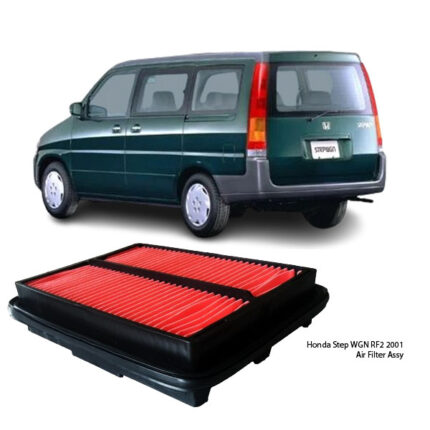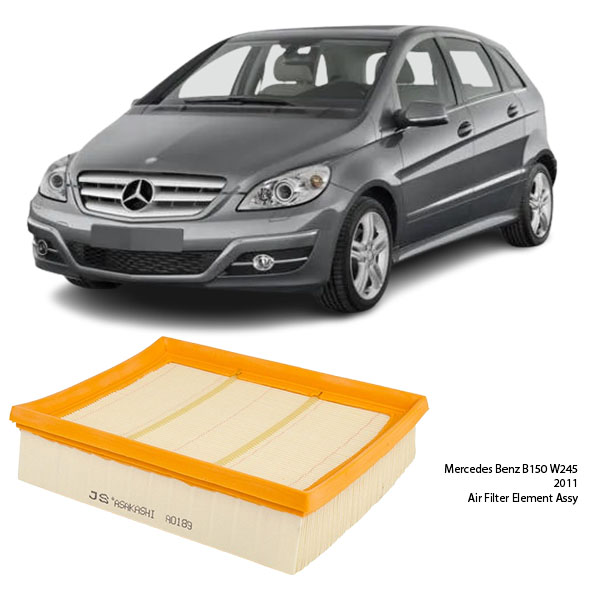-25%
Get Mercedes Benz B150 W245 Air Filter Element Assy A 266 094 00 04 in Kenya
The Air Filter Element Assembly is a crucial component in a vehicle’s intake system, responsible for filtering out dust, dirt, debris, and other contaminants before they enter the engine. A clean air supply is essential for efficient combustion, ensuring optimal engine performance, fuel efficiency, and longevity.
Air filter elements come in various shapes and materials, depending on the vehicle’s make and model. Over time, they accumulate dirt and require regular replacement to prevent engine damage, reduced fuel efficiency, and poor performance.
This guide provides an in-depth explanation of the air filter element assembly, including its function, types, benefits, signs of wear, and maintenance tips.
2. What is an Air Filter Element Assembly?
The air filter element assembly is a replaceable filtration unit housed in the air filter box of the vehicle. It allows clean air to pass through while trapping harmful particles.
2.1 Components of an Air Filter Element Assembly
- Filter Media – Made from paper, cotton, foam, or synthetic materials, responsible for trapping contaminants.
- Rubber or Plastic Frame – Provides a sealed fit to prevent unfiltered air from entering the engine.
- Support Mesh or Pleated Design – Enhances airflow while maintaining filtration efficiency.
- Gasket or Sealing Ring – Ensures a secure fit, preventing leaks.
2.2 How Does an Air Filter Work?
- Air enters the intake system through the filter housing.
- The filter element traps dirt, dust, and debris, allowing only clean air to pass.
- Clean air enters the engine cylinders, where it mixes with fuel for combustion.
- The filter ensures the engine receives the right air-to-fuel ratio, improving efficiency.
3. Types of Air Filter Elements
3.1 Paper Air Filters (Most Common)
- Made from pleated paper.
- Inexpensive and disposable.
- Effective at capturing small particles.
3.2 Cotton Air Filters (Reusable & High-Performance)
- Made from oiled cotton gauze layers.
- Reusable and washable.
- Allows better airflow, improving engine performance.
3.3 Foam Air Filters (For Off-Road & Racing Applications)
- Thick foam layers trap larger particles.
- Ideal for dusty and off-road environments.
- Requires regular oiling and maintenance.
3.4 Synthetic Air Filters (Advanced Filtration)
- Uses multi-layer synthetic fibers.
- Offers high airflow and superior filtration.
- Common in modern high-performance vehicles.
4. Benefits of a High-Quality Air Filter Element
4.1 Improved Engine Performance
- Clean air supply ensures optimal fuel combustion, leading to smooth acceleration and power output.
4.2 Enhanced Fuel Efficiency
- A clogged air filter reduces airflow, causing the engine to burn more fuel.
- A clean filter helps maintain an optimal air-fuel ratio, improving fuel economy.
4.3 Protection Against Engine Damage
- Prevents dust, dirt, and debris from entering the combustion chamber.
- Reduces wear on pistons, cylinders, and valves.
4.4 Reduced Emissions
- A clean filter ensures complete combustion, reducing harmful emissions like carbon monoxide and hydrocarbons.
4.5 Extended Engine Life
- Protects the engine from premature wear and tear caused by contaminants.
5. Signs of a Dirty or Failing Air Filter
5.1 Reduced Engine Performance
- Sluggish acceleration and poor throttle response indicate restricted airflow.
5.2 Decreased Fuel Efficiency
- If the engine burns more fuel than usual, a clogged air filter could be the cause.
5.3 Black Smoke from Exhaust
- Incomplete combustion due to insufficient air supply can produce black exhaust smoke.
5.4 Check Engine Light (CEL) Warning
- A dirty filter can trigger oxygen sensor or mass airflow sensor issues, causing the CEL to illuminate.
5.5 Unusual Engine Sounds
- A blocked filter may cause the engine to misfire or make rough idling noises.
5.6 Dirt and Debris on the Filter Surface
- A visible buildup of dust and dirt means it’s time to replace or clean the filter.
6. Causes of Air Filter Contamination
6.1 Driving in Dusty or Off-Road Conditions
- More dust and debris lead to faster clogging.
6.2 Poor Maintenance Practices
- Delayed replacements or cleaning reduce filter efficiency.
6.3 Exposure to Polluted Environments
- Urban areas with high vehicle emissions increase filter contamination.
6.4 Oil Contamination from the Engine
- A failing Positive Crankcase Ventilation (PCV) valve can send oil vapors into the intake, clogging the filter.
7. Air Filter Maintenance and Replacement
7.1 How Often Should You Replace an Air Filter?
- Standard air filters last 15,000 to 30,000 km (9,000 to 18,000 miles).
- Vehicles in dusty conditions may need replacement every 8,000 to 10,000 km.
7.2 Steps to Replace an Air Filter
Tools Required:
- New air filter (OEM or high-performance replacement).
- Screwdriver or wrench (if needed for airbox removal).
Step-by-Step Guide:
-
Locate the Air Filter Box
- Typically found in the engine bay near the intake manifold.
-
Open the Air Filter Housing
- Unclip or unscrew the cover.
-
Remove the Old Air Filter
- Check for excessive dirt buildup.
-
Clean the Housing (Optional)
- Use compressed air or a damp cloth to remove dust.
-
Install the New Filter
- Ensure a proper fit within the housing.
-
Secure the Air Filter Box
- Clip or screw the housing back in place.
-
Start the Engine and Test
- Listen for any unusual noises and ensure smooth performance.
8. Cost of Air Filter Replacement
- Standard Paper Filters: $10 – $30
- High-Performance Cotton Filters: $40 – $80
- Professional Replacement (Labor Cost): $20 – $50
- Total Cost: $30 – $130 (depending on the vehicle and filter type)
9. Common Myths About Air Filters
❌ “Air Filters Don’t Affect Performance”
✅ A clogged filter reduces airflow, impacting acceleration and power.
❌ “You Never Need to Replace Air Filters”
✅ Air filters wear out over time and require periodic replacement.
❌ “Washing Paper Air Filters Extends Their Life”
✅ Paper filters are not washable; only reusable cotton or foam filters can be cleaned.
❌ “Aftermarket Performance Filters Damage Engines”
✅ High-quality performance filters enhance airflow and durability without harming the engine.
10. Conclusion
The air filter element assembly is a small yet essential component in a vehicle’s air intake system. It ensures a clean airflow, promoting efficient combustion, better fuel economy, and extended engine life.
Regular inspection and timely replacement help maintain optimal engine performance and emissions control. For best results, always choose OEM or high-quality aftermarket filters and follow manufacturer recommendations for replacement intervals.
By maintaining a clean air filter, you can keep your engine running smoothly and efficiently for years to come. 🚗💨
Follow us on Facebook for more parts.



